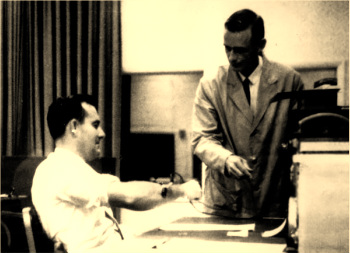The Electric Shock Experiment

A photo of the experimenter preparing a participant
Purpose: To test how obedient an average person would be to the requests of an authority figure, even if the requests are immoral or unreasonable.
Sample: 40 male volunteers
Setting: Milgram’s laboratory at Yale University
Method:
1. For each session of his experiment, Milgram used two people; one to play the part of the teacher, and the other to play the part of the learner. Because the experiment was meant to test the teachers' behavior, not the learners', Milgram had his assistant, James McDonough play the part of the learner each time. In order for the experiment to yield accurate results, the participants weren't allowed to know this. Milgram's other assistant, John Williams played the part of the experimenter. The participants that volunteered were always unknowingly chosen as the teachers. Milgram wanted to test whether normal, everyday people would inflict pain on a stranger simply because the experimenter, the authority figure, told them to (Nairne 433).
2. The learner’s job was to memorize lists of word pairs and recall them to the teacher (Nairne 433).
3. The teacher’s job was to administer an electric shock to the learner each time he made a mistake, using a higher level of voltage each time. The voltage started at 15 and went all the up to 450 volts, a lethal shock. The teacher sat in front of a large electric shock generator, with the experimenter in a gray lab-coat by his side hovering as he read and administered shocks (Nairne 434).
4. As each session progressed, the learner, who remember, was secretly a confederate to the experimenter, made mistakes and received electric shocks from the teacher. As the voltage got higher, the learner began to groan, yell, and demand to be let out, begging the teacher to stop. Once the teachers had reached around 350 volts, the learner simply became quiet (Nairne 434).
5. Most of the teachers were highly concerned about the pain they thought they were inflicting on the learner and wanted to stop the experiment, yet the experimenter firmly encouraged them to continue, only saying that the experiment had to go on (Nairne 434).
Results:
-65% of the 40 volunteers delivered the max voltage of shocks-450 volts, which was lethal. This would be considered obedient (Nairne 434).
- None of the volunteers stopped before the learner began pounding on the walls (Nairne 434).
-According to Blass's website, Milgram found no differences in obedience between men and women, though women reported more stress.
Sample: 40 male volunteers
Setting: Milgram’s laboratory at Yale University
Method:
1. For each session of his experiment, Milgram used two people; one to play the part of the teacher, and the other to play the part of the learner. Because the experiment was meant to test the teachers' behavior, not the learners', Milgram had his assistant, James McDonough play the part of the learner each time. In order for the experiment to yield accurate results, the participants weren't allowed to know this. Milgram's other assistant, John Williams played the part of the experimenter. The participants that volunteered were always unknowingly chosen as the teachers. Milgram wanted to test whether normal, everyday people would inflict pain on a stranger simply because the experimenter, the authority figure, told them to (Nairne 433).
2. The learner’s job was to memorize lists of word pairs and recall them to the teacher (Nairne 433).
3. The teacher’s job was to administer an electric shock to the learner each time he made a mistake, using a higher level of voltage each time. The voltage started at 15 and went all the up to 450 volts, a lethal shock. The teacher sat in front of a large electric shock generator, with the experimenter in a gray lab-coat by his side hovering as he read and administered shocks (Nairne 434).
4. As each session progressed, the learner, who remember, was secretly a confederate to the experimenter, made mistakes and received electric shocks from the teacher. As the voltage got higher, the learner began to groan, yell, and demand to be let out, begging the teacher to stop. Once the teachers had reached around 350 volts, the learner simply became quiet (Nairne 434).
5. Most of the teachers were highly concerned about the pain they thought they were inflicting on the learner and wanted to stop the experiment, yet the experimenter firmly encouraged them to continue, only saying that the experiment had to go on (Nairne 434).
Results:
-65% of the 40 volunteers delivered the max voltage of shocks-450 volts, which was lethal. This would be considered obedient (Nairne 434).
- None of the volunteers stopped before the learner began pounding on the walls (Nairne 434).
-According to Blass's website, Milgram found no differences in obedience between men and women, though women reported more stress.
Four Scenarios on Proximity

A photo Milgram's fourth scenario
Milgram's first four rounds of his study were "designed to determine whether varying the physical and psychological distance between the teacher-subject and the learner would affect the degree of obedience" (Blass 93).
Scenario 1: The "remote condition." Milgram had the teacher sit in front of the shock machine while the learner sat in a room next to him. The teacher could neither see, nor hear the learner. The only evidence of the learner's answers came through in a light-up number in the answer box on the electric shock machine (Blass 94).
Results:
-No teacher stopped obeying before he reached 300 volts.
-65% of the subjects were fully obedient in reaching the 450 volt maximum (Blass 94).
Scenario 2: The "voice feedback condition." The learner and the teacher were in different rooms, but this time the teacher could hear the learner's prerecorded protests of pain (Blass 95).
Results: A decrease in obedience: 62.5% of the subjects used the maximum 450 voltage of shocks (Blass 95).
Scenario 3: the "proximity condition." The teacher and the learner were seated a couple feet away, meaning the learner had to act, instead of there just being a prerecorded voice as in the first two scenarios. This time, the teacher witnessed the bodily reaction the learner had from the pain each time he was shocked (Blass 95).
Results: A further decrease in obedience: 40% of the subjects used the maximum 450 voltage (Blass 95).
Scenario 4: the "touch-proximity condition." The teacher and the learner sat next to each other, but this time the learner had to put his hand on the shock plate to receive the shock. If the learner refused to go on with this, the teacher was ordered to physically force his hand onto the shock plate. Milgram was shocked by the results (Blass 96).
Results: By 150 volts, the learner refused to put his hand on the shock plate (Blass 96).
30% of the teachers forced the learners to have shocks up to 450 volts with physical coercion (Blass 96).
Conclusion: The closer the teacher was to the learner, the less likely he was to continue the shocks, probably because hearing and seeing the learner's pain triggered empathy, and gave him proof of the pain he was inflicting.
Milgram commented that "It [was] a very disturbing sight...since the victim [resisted] strenuously and [emitted] cries of agony" (Blass 96).
Milgram described one experience in particular as "brutal and depressing." The teacher's "hard, impassive face [showed] total indifference as he [subdued] the screaming learner and [gave] him shocks." He "[seemed] to derive no pleasure from the act itself, only quiet satisfaction at doing his job properly" (Blass 96).
Scenario 1: The "remote condition." Milgram had the teacher sit in front of the shock machine while the learner sat in a room next to him. The teacher could neither see, nor hear the learner. The only evidence of the learner's answers came through in a light-up number in the answer box on the electric shock machine (Blass 94).
Results:
-No teacher stopped obeying before he reached 300 volts.
-65% of the subjects were fully obedient in reaching the 450 volt maximum (Blass 94).
Scenario 2: The "voice feedback condition." The learner and the teacher were in different rooms, but this time the teacher could hear the learner's prerecorded protests of pain (Blass 95).
Results: A decrease in obedience: 62.5% of the subjects used the maximum 450 voltage of shocks (Blass 95).
Scenario 3: the "proximity condition." The teacher and the learner were seated a couple feet away, meaning the learner had to act, instead of there just being a prerecorded voice as in the first two scenarios. This time, the teacher witnessed the bodily reaction the learner had from the pain each time he was shocked (Blass 95).
Results: A further decrease in obedience: 40% of the subjects used the maximum 450 voltage (Blass 95).
Scenario 4: the "touch-proximity condition." The teacher and the learner sat next to each other, but this time the learner had to put his hand on the shock plate to receive the shock. If the learner refused to go on with this, the teacher was ordered to physically force his hand onto the shock plate. Milgram was shocked by the results (Blass 96).
Results: By 150 volts, the learner refused to put his hand on the shock plate (Blass 96).
30% of the teachers forced the learners to have shocks up to 450 volts with physical coercion (Blass 96).
Conclusion: The closer the teacher was to the learner, the less likely he was to continue the shocks, probably because hearing and seeing the learner's pain triggered empathy, and gave him proof of the pain he was inflicting.
Milgram commented that "It [was] a very disturbing sight...since the victim [resisted] strenuously and [emitted] cries of agony" (Blass 96).
Milgram described one experience in particular as "brutal and depressing." The teacher's "hard, impassive face [showed] total indifference as he [subdued] the screaming learner and [gave] him shocks." He "[seemed] to derive no pleasure from the act itself, only quiet satisfaction at doing his job properly" (Blass 96).
